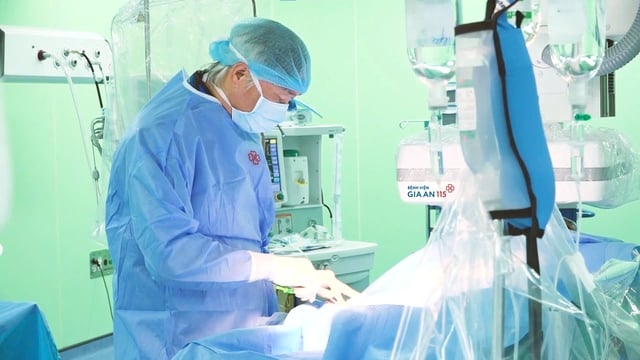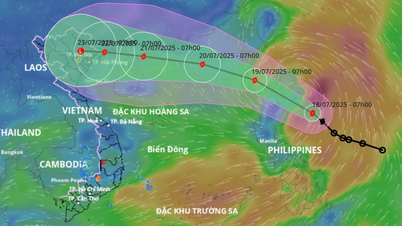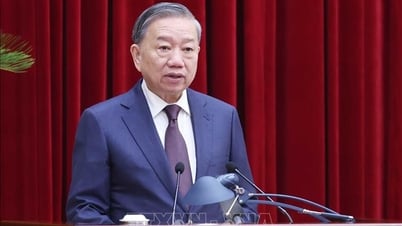Specialist Doctor 2 Duong Duy Trang, Head of the Department of Internal Medicine - Interventional Cardiology, Gia An 115 Hospital, said that recently doctors had received and successfully treated a case of critical myocardial infarction.
The patient, Mr. THT (40 years old, residing in Binh Tan District, Ho Chi Minh City), was brought to the emergency room with epigastric pain accompanied by severe left chest pain spreading to the left arm, heavy and tired left arm, sweating, and difficulty breathing. The patient's symptoms started in the evening of the same day, and he went to the local medical center and was given medication but it did not improve. When difficulty breathing appeared, he was transferred to Gia An 115 Hospital.
Doctor Duong Duy Trang intervenes on a patient
Photo: BVCC
Both blocked critical location and late hospitalization
In the Emergency Room, the results of the electrocardiogram and bedside echocardiogram showed that the patient had an acute myocardial infarction with ST elevation and a left ventricular ejection fraction (EF) of 49%. This is the most dangerous form of myocardial infarction, caused by a complete blockage of one or more coronary arteries that supply blood to the heart. Doctors immediately “raced against time” to protect the patient’s life and minimize heart damage.
Notably, the angiography results at the DSA room recorded that the patient had acute occlusion of the distal end of the left coronary artery - one of the most dangerous stenosis locations. The THT patient's case was even more complicated because the occlusion was located at the distal end of the common trunk, close to the branching point, requiring careful calculation of the process of inserting the guidewire, balloon and stent. If the operation is not performed correctly, the risk of dissection of the vessel wall or occlusion of other branches is very high.
“This is a critical case, with both a blockage in a critical location and late admission. The patient was taken to the emergency room at Gia An 115 Hospital about 4-5 hours after the onset of symptoms. Without timely and effective intervention, the risk of death is very high,” said Dr. Duong Duy Trang.
Dr. Duong Duy Trang and his team quickly placed a drug-eluting stent at the end of the common trunk. After passing the guidewire past the blockage, the doctor performed balloon dilation and placed the stent precisely, helping to restore flow to both the LAD and LCx branches.
After the intervention, the patient's chest pain was gone, hemodynamics gradually stabilized with vasopressors and then stopped, cardiac enzymes gradually returned to normal levels. The patient has now been discharged and continues to receive outpatient treatment according to the post-myocardial infarction regimen.
Myocardial infarction does not always present with typical symptoms of chest pain and shortness of breath.
Photo: AI
Myocardial infarction does not always manifest with chest pain and shortness of breath.
Through the case of patient T., Dr. Duong Duy Trang warned that myocardial infarction does not always manifest itself typically with angina and shortness of breath. In addition to these two signs, the patient may experience a feeling of heaviness in the chest; pain in the chest, back, jaw, arm or epigastric region; unusual fatigue; cold sweats; nausea, vomiting; sudden dizziness or lightheadedness, rapid heart rate... The symptoms may be fleeting and vague, so the patient needs to be vigilant. If any of the above unusual symptoms appear, the patient should immediately go to a medical facility capable of cardiovascular intervention for timely diagnosis and treatment. The "golden hour" in the treatment of myocardial infarction is the first 1-2 hours from the onset of symptoms.
Dr. Duy Trang said that good control of risk factors plays a key role in preventing myocardial infarction. Risk factors include: smoking, sedentary lifestyle, unhealthy diet, high blood pressure, diabetes, gout, lipid disorders, etc. In addition, the risk also increases in men, middle-aged people, and people with a family history of cardiovascular disease. If you are in the high-risk group, you need to pay attention to regular health check-ups, adjust your lifestyle, and control your underlying medical conditions well to minimize the risk of myocardial infarction as well as other cardiovascular diseases.
Source: https://thanhnien.vn/dau-thuong-vi-tuong-benh-da-day-khong-ngo-la-nhoi-mau-co-tim-cap-185250509105833071.htm



































































































![[Infographic] In 2025, 47 products will achieve national OCOP](https://vphoto.vietnam.vn/thumb/402x226/vietnam/resource/IMAGE/2025/7/16/5d672398b0744db3ab920e05db8e5b7d)





Comment (0)